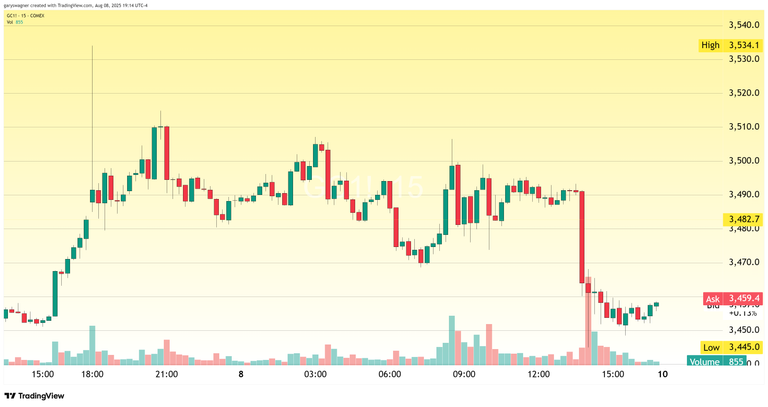Gold markets experienced extraordinary volatility this week as traders grappled with confusion surrounding the precious metal's exemption status under newly implemented reciprocal tariffs targeting Switzerland, one of America's largest gold trading partners. The uncertainty underscores the complex intersection of trade policy and commodity markets in an increasingly fragmented global trading environment.
Market Turbulence Reflects Policy Confusion
The precious metals sector witnessed one of its most dramatic trading sessions in recent memory as market participants struggled to interpret the implications of the revised 2025 Harmonized Tariff Schedule (HTS). Gold futures surged to a new all-time high of $3,534.10 before retreating sharply below $3,500 within a mere 15-minute window, highlighting the intense uncertainty pervading the market.
By session's end, gold futures had declined $24.50, or 0.70%, to close at $3,458.20, while spot gold managed modest gains of $1.28, or 0.04%. This divergence occurred despite moderate dollar strength, with the U.S. Dollar Index advancing 0.22% to 98.26, typically a headwind for gold prices.

The Swiss Tariff Framework
Switzerland now faces a punitive 39% tariff on goods imported to the United States, effective August 7, 2025, representing one of the highest tariff rates globally. Critically, Switzerland does not appear among the preferential country codes that receive reduced tariff rates under the current trade framework, forcing Swiss imports to face full "General" tariff rates.
However, the impact on precious metals is nuanced and product-specific. Under Chapter 71 of the tariff schedule, raw precious metals maintain their advantaged status. Gold powder, bullion, and dore remain duty-free universally, as do rectangular gold bars meeting 99.5% purity standards. Similarly, silver powder, bullion, and high-purity rectangular bars continue to enter duty-free.
The distinction becomes significant for processed and manufactured precious metal products. Semi-manufactured gold faces a substantial 65% duty, while gold jewelry confronts tariffs ranging from 80% to 110%. Silver products follow a similar pattern, with semi-manufactured forms subject to 65% duties and jewelry facing the highest rates.
The tariff structure reveals important nuances in precious metals trading that many market participants initially overlooked. While duty-free status for bullion and dore might appear favorable, these products serve a limited market consisting primarily of specialized refiners and mints. Dore, typically containing 50% to 90% precious metal content compared to investment-grade bullion's minimum 95.5% purity, represents rough processing output from mining operations and rarely trades in open markets.
This distinction matters because the broader investment and industrial demand for precious metals typically involves higher-grade processed products, which now face significantly elevated costs when sourced from Switzerland. The policy effectively creates a two-tiered market structure that could reshape supply chain dynamics and trading patterns.
The volatility in gold markets reflects broader uncertainties surrounding U.S. trade policy and its impact on established commodity trading relationships. Switzerland's status as a major gold trading hub, combined with the complexity of the tariff schedule, has created an environment where traders must navigate not only traditional market fundamentals but also evolving regulatory frameworks.
The market's initial reaction—a sharp spike followed by equally dramatic retreat—suggests that algorithmic trading systems and momentum-driven strategies may have amplified the underlying confusion. This pattern highlights the increasing importance of policy clarity in maintaining orderly commodity markets.
Looking Forward
As market participants continue to analyze the full implications of the revised tariff schedule, several key factors will likely influence precious metals trading. The distinction between raw and processed materials creates arbitrage opportunities while potentially disrupting established supply chains. Additionally, the precedent of applying targeted tariffs to major trading partners raises questions about similar measures affecting other commodity flows.
The current situation exemplifies how trade policy decisions can create immediate market volatility even in traditionally stable sectors like precious metals. For investors and traders, the episode underscores the importance of understanding not just market fundamentals but also the evolving regulatory landscape that increasingly influences commodity pricing and trading patterns.
The gold market's reaction to Swiss tariff policy may prove to be an early indicator of how commodity markets will adapt to a more fragmented and policy-driven global trading environment.
For those that would like more information about our services click here.
Wishing you as always good trading,


